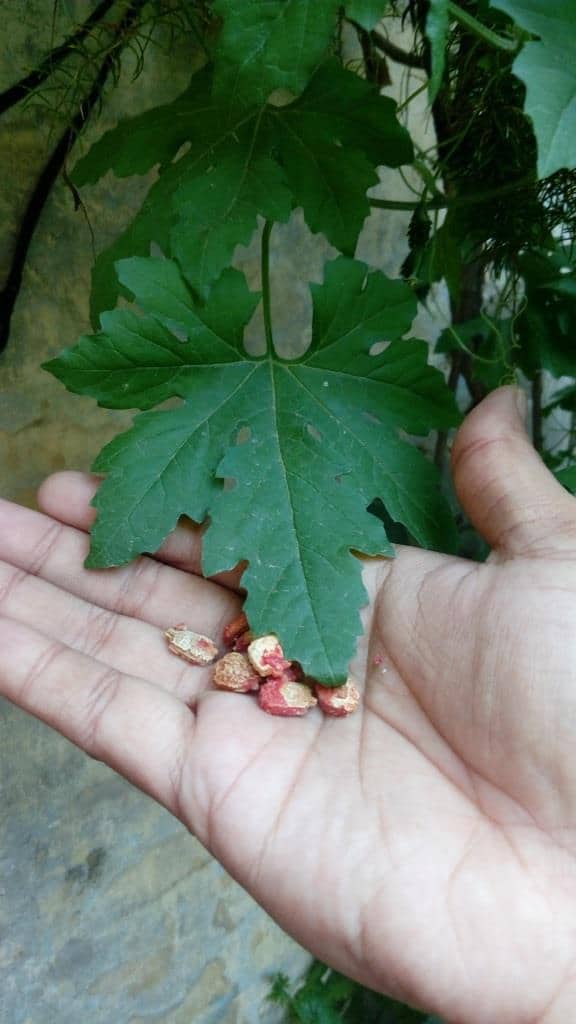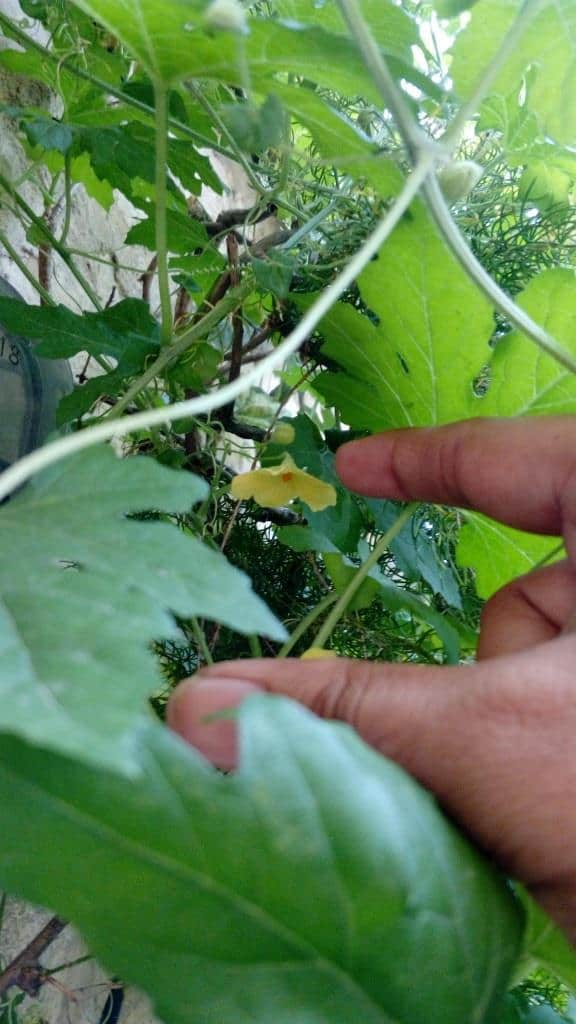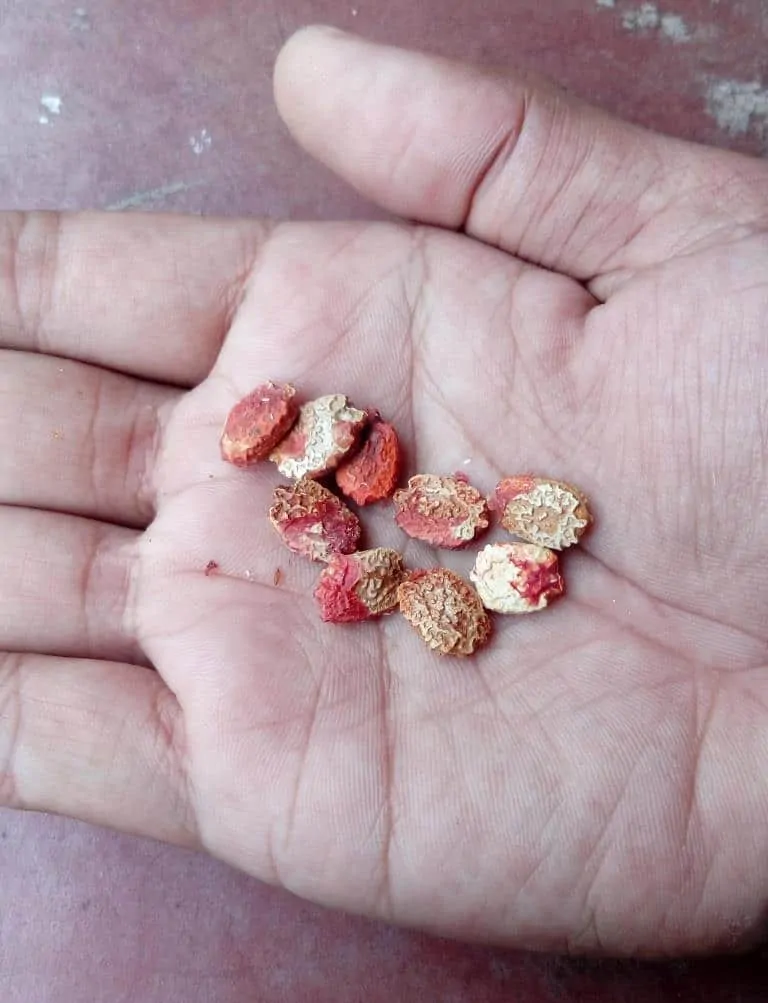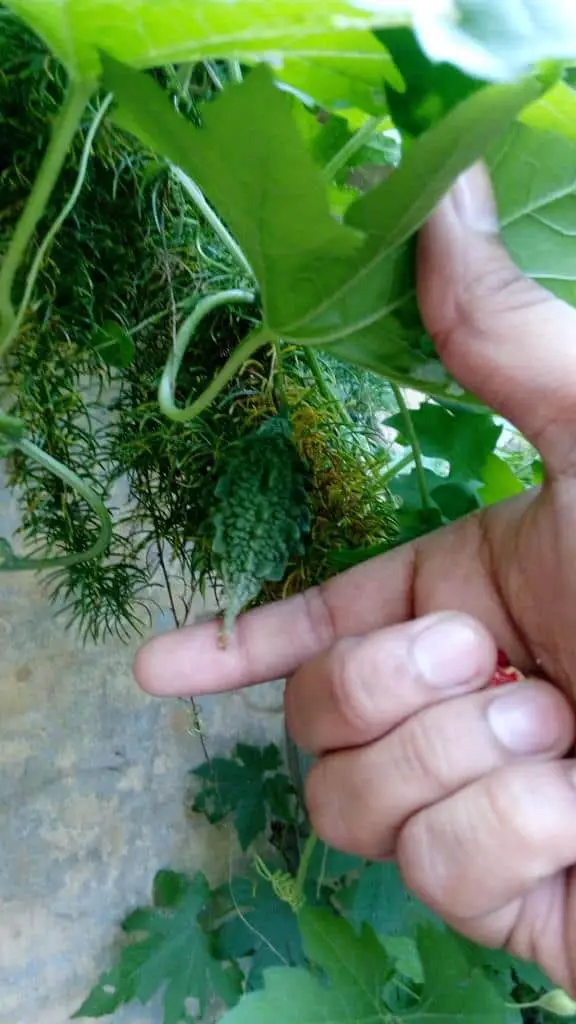Bitter Gourd or Bitter melon is a member of the Cucurbitaceae family. It shares the place with other members of the family like Cucumber and other gourds. bitter is famous for its bitter taste. In fact, it is one of the most bitter fruit you could ever have. Still, we grow it. Why? Coz people love it. It is healthy and adds a unique flavor to your plate.
Read my previous article on: Is Bitter gourd annual or perennial?-Kitchen Garden facts

Buy bitter gourd seeds online.
What is Bitter Gourd or Bitter melon?
As the name suggests, It is a gourd, a fruit with an extremely bitter taste. It is an edible fruit with a cylindrical shape and uneven outer skin. Don’t think too hard, I have an image for you.
Bitter gourd is native to the tropical climate. In the US, it is mostly grown in Zones 6-11. USDA Zone 10 and 11 is ideal for growing Bitter gourds.
The Scientific name of bitter gourd is Momordica charantia. It belongs to the Cucurbitaceae family. It has a hollow center filled with hard flat seeds. The seeds are light yellow to white in color.
The leaves are round when germinated. True leaves of bitter gourd have three distinct edges. It is unique to identify. The size of the leaves varies from 2 cm to 9 cm. Sometimes you can find tiny hair-like structures over these leaves.

A tropical climate is ideal for bitter gourd or bitter melons. It needs temperature above 20 degrees celsius to germinate and above 26 degrees to start flowering.
Bitter gourd produces yellow unisexual flowers. It means a single plant produces both male and female flowers separately. This is very common with all the members of the Cucurbitaceae family.

Fertilization takes place by the wind or by some pollinators like bees. The vines of bitter gourd can grow as long as 5 meters. These plants are rapid growers. Their life span is short with a maximum fruiting time of 65 days.
Bitter gourd loves well drainage soil. The soil should be moist and fertile for the best results.
Now Do you wanna grow your own bitter gourd?-If yes then keep reading for detailed information.
How to Grow Bitter Gourd at home?
Here comes the first question- Can you grow bitter gourd at home?- Yes, you can easily grow bitter gourd at your home.
You just need 3 essential things. These are-
- Good Quality Bitter gourd or melon seeds.
- Growing Media like Soil and compost.
- Regular watering and care.
Ok, It seems more than three but I think this is it. These are the minimum requirement for growing a fruitful bitter gourd plant at home.
Now let’s discuss each of these in detail. First, you need some seeds. Yes, some good quality fresh viable seeds to grow bitter gourd is necessary. Here comes the second question-
Where to get quality bitter gourd seeds for growing?
Quality Seed is important for every plant. You should select only the best quality fresh seeds for growing bitter gourd.
You can buy some seeds online on Amazon or visit your nearest seed store. Always check the details for the date of packing and viability percentage and germination details given on the packet.
If you are purchasing seeds from the local farmer ask him for proper details. Bitter gourd Seeds should be clean dry and free from diseases.
I have another option if you don’t’ want to buy seeds. Just get some mature bitter gourd or melon fruits from the grocery store. It should be slightly yellow in color and probably won’t cost you much. These fruits are of no use for them so just ask for a favor and you can get it for free.
Now Market bought seeds are clean and ready to grow but fresh seeds need some care. First, you have to clean it up. Seeds are covered with red flesh in a mature bitter gourd. This is a natural protective shield for the seeds. So the third question arises.

How to get seeds from a mature bitter gourd?
- Cut the mature fruit and collect all the seeds. These seeds are flat and have hard outer covering. A red flesh like pith is surrounding the whole seeds. This is to protect the seed and also slowdowns the germination process.
- Soak the seeds for a few hours in freshwater. Then wash off the red portion carefully. Rinse the seed twice or more clean it completely.
- Now you can use these seeds for germination or dry them and store them for next season.
How to Germinate Bitter gourd seeds?
The bitter gourd seeds are really hard and can take up to 15 days to germinate. With proper knowledge and care, we can reduce this time to just 5-7 days. It is really fast, it could save you a whole month with extra fruiting.
- Soak the seeds for 24 hours. Use fresh water for this purpose. Leave these seeds in a warm place but not in direct sun.
- After the first step, you have to provide the proper medium of germination to the soaked seeds. You can use some paper towel or growing media for this purpose. I have shared both the steps below, read carefully before trying.
- Here’s an optional tip. Make a small cut in the lower portion of the seeds before soaking. The covering of bitter gourd seed is hard. It is there to protect the softcore. Also, this hard covering slows down the germination process. So if you allow some moisture to move in quickly then it will germinate faster. Remember this is optional and can damage the seeds if something went wrong. So just try to break the shell without damaging the inner soft seed.
How to germinate bitter gourd seed using a paper towel?
- Soak the seeds for at least 24hour in fresh drinking water.
- Wrap these seeds in paper towel carefully. Spray some water over it to maintain the moisture. Don’t soak it entirely. Excess of water can cause a fungal attack.
- Seal everything together in an airtight zip bag or plastic container. Leave the container in a warm location. A kitchen solve is the best place for this job.
- The seeds will start to germinate within 7-9 days. Take out each germinated seed carefully.
- Place one seed per pot to develop healthy seedling. Use 4-inch pots or containers for this purpose. Also, you should use healthy highly nutritious soil mix to develop the seedlings.
How to Germinate bitter gourd seeds in soil and compost mix?
- Prepare a mix of 50% garden soil and 50% compost. You can add some cocopeat or perlite if you want.
- Fill the pots and containers with this mix. Leave at least 3/4th inch to the top of the pot. It is required for proper watering.
- Place soaked seed in the soil. Cover the seeds with 1/2 inch of the same soil mix.
- Water it thoroughly for the first time. You can add some contact fungicide for the protection of seeds from fungi.
- Cover the pot with newspaper or any magazine paper. This is required only if the temperature in your area is below 22 degrees Celcius. You can also use thermal blankets if you think it’s necessary. Else just place the pots in the warm shady region for 3 days.
- You can move these seeds in full sun from day four. Don’t worry the seeds are very hardy and can tolerate such a situation.
- Just water the soil whenever necessary. Don’t make it soggy. Keep it warm and moist.
- The seeds will start germinating from the 5th -7th day. According to temperature and moisture, this time can vary. So don’t worry if your seeds are late growers. Just care for them.
How to grow bitter gourd seedlings?
Once germinated successfully, these seeds can be directly grown in pots or ground. This is easy but takes time and space to observe the best outcomes. An alternative to this is to prepare a healthy seedling first and then transplant it to the desired spot. If you choose the second method then read my steps carefully for the best result.
- Take 4inch soft plastic seedling pot or just some reusable plastic cups. Don’t waste the cups currently in use or you have to sleep without food tonight.
- Make a mix of 30% garden soil, 30% compost, 30% cocopeat, and 10% vermiculite or perlite. This soil mix is ideal for Bitter gourd seedlings.
- Fill the pots up to the top. leave 1-inch space on the top.
- Place 1 germinated seed in each pot. You can put two if you want. Remember proper spacing is an important factor for growing healthy seedlings.
- Each seed should be placed vertically down. Place it just 1/4 inch below the surface of the soil. The root should be placed downward. Press the soil gently to make the seed firm in place.
- Water it carefully. The first time you can make the soil completely wet. From next time water only when it required.
- Place the pots in a warm place. This time they will need sunlight. So you can place a grow light over it or move the pots near the window.
- Within 2-3 days you will see the first 2 primary leaves ready. These leaves are different from real bitter gourd leaves. These are round and broad.
- The seedlings will be ready to transplant in 7-10 days. Transplanting should be done only when the first 4 true leaves have emerged successfully.
How to Transplant seedlings of Bitter Gourd?
Transplanting Bitter gourd seedlings is very easy. They grew a lot of fibrous roots to support the entire structure. So just take the seedling out of the pot. Place the seedling to the desired space or pot without damaging the root ball. That’s all you have to do.
Now on just water and fertilize the baby bitter gourd and it will start fruiting within a month.
Problems with Bitter Gourd?
Bitter gourd plants are strong enough to survive in harsh climatic conditions. Still, some problems are common with bitter gourd plants.
- Yellowing of leaves. Overwatering or overheating is the main reason for the yellowing of leaves in bitter gourd. Other than these some fungal diseases can also cause yellowing in leaves.
- Black or Red Spots on the leaves. You can find some red-brown or even black spots on the mature leaves of bitter gourd. But if this is common with fresh leaves then be careful. This can be dure to fungal or bacterial attack. Sometimes lack of nutrition can also cause these spots. So first check for soil quality then doubt for any fungal attack.
- Mildew and aphids. These are the tiny insects common for bitter gourd. If your plant is not getting proper sunlight and you keep on watering and fertilizing it. Then you will definitely gonna see these nasty little creatures. Read my previous post for Curing these pests effectively.
- Root Rot. Overwatering can cause root rot in the bitter gourd plant. These plants are native to tropical climate but they cannot survive in soggy soil. The soil should be moist and well aerated for avoiding root rot.
Caring Bitter gourd plants?
- Regular watering is important to keep these plants healthy. Bitter gourd loves moist soil. Regular watering is a key factor for more fruiting.
- Prune dead branches. Bitter gourd is a vine, so once you cut the tip more branches will come out. More branches mean more healthy fruits. So regular pruning is a good practice.
- fertilize once every month with only organic compost. Don’t use any chemical fertilizer. It is not required and also not very good for health. You can use compost made from organic kitchen waste. It is an easy low cost and environment-friendly way of fertilization.
- Remove weeds regularly. Bitter gourd is an annual vegetable plant. It needs proper space and nutrition for heavy fruiting. Weeds can quickly consume this nutrition and create scarcity for the bitter gourd plants. So it is important to remove weeds whenever required. Keep the pot and soil clean as much as you can.
Harvesting Bitter Gourd?
You can harvest bitter melon or gourds once every 7-10 days from each plant. Give the plants enough time to grown and develop better, bigger gourds.

Bitter gourd or melons bigger than 3 inches can be harvested. It is generally used as a green vegetable. But you can also use it after turning yellow. It really depends on the use of these fruits. Harvest these whenever you need them. Fresh green garden products are always best and better than any grocery store.
Final Words
You just need some seeds, soil, water, and care to grow your own bitter melon. It is easy to grow and healthy to eat. Have you ever grow bitter gourd? what was your experience with these bitter fruit vegetables? Share your views and suggestions below in the comment box.
I’ll be back with something new and interesting. Till then keep reading and keep gardening.
Live green!
